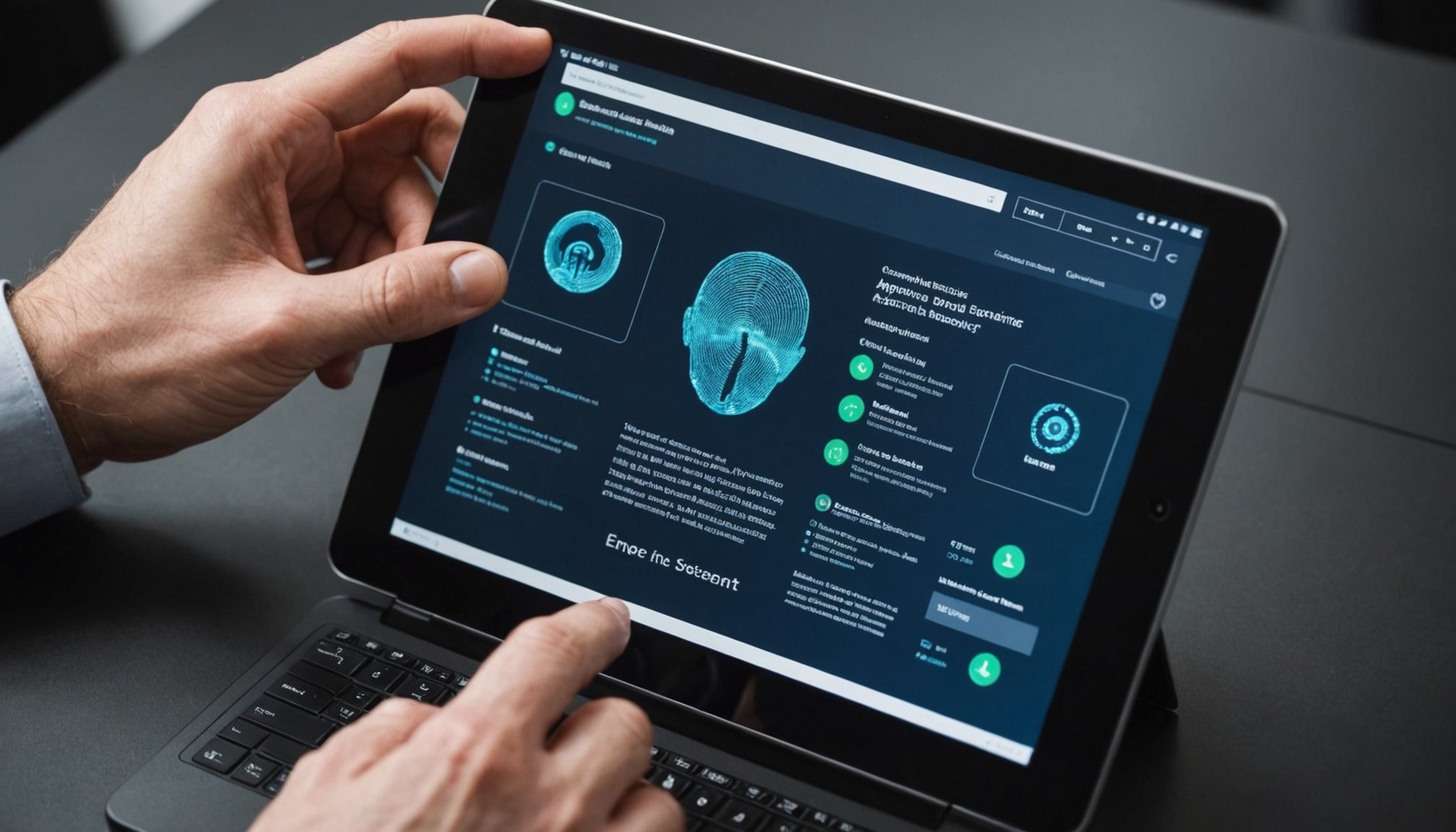Overview of Biometric Authentication in the UK
Biometric Authentication is the technology that confirms a person’s identity through their unique biological traits, such as fingerprints, facial recognition, and iris scans. Its usage in the UK is growing rapidly across varying sectors, with businesses finding it an effective and secure means of identity verification. An increasing number of companies choose biometric solutions for enhancing security and customer experience.
However, as these technologies become more commonplace, understanding UK regulations around their implementation is crucial. Businesses must ensure their practices comply with legal standards, such as the General Data Protection Regulation (GDPR) in the UK which emphasizes the lawful, fair, and transparent handling of personal data.
Additional reading : Navigating the Legal Maze: Key Strategies for UK Businesses Harnessing AI in Content Moderation
Navigating the legal landscape requires careful attention to the implications of using biometric data. Non-compliance can lead to severe consequences, including fines and reputational damage. Therefore, companies must ensure that their biometric systems adhere to the compliance requirements set by UK authorities. This involves staying informed about the latest regulatory frameworks and updates concerning the deployment and data protection of biometric systems.
Key UK Laws Governing Biometric Data
In the UK, the protection of biometric data is governed by stringent regulations. The UK General Data Protection Regulation (UK GDPR) plays a pivotal role in managing how personal data, including biometric information, is processed and safeguarded. It’s crucial for businesses to understand that biometric data is considered a special category under UK GDPR, requiring extra layers of protection. This regulation emphasizes the need for lawful and transparent data handling, mandating organizations to establish clear purposes for data collection and ensure that it’s kept secure.
Have you seen this : Essential Legal Factors for UK Businesses Implementing AI in Customer Service Solutions
Complementing the UK GDPR is the Data Protection Act 2018, which aligns with the GDPR while addressing national specifics. It reinforces the obligations businesses have in securing biometric data, outlining the requirements for lawful processing and enforcement of rights for data subjects.
Comparatively, while general personal data requires protection under these laws, biometric data is subject to more stringent protocols due to its sensitive nature. Unlike standard personal data, biometric information can uniquely identify individuals, thus demanding higher compliance to prevent misuse. Understanding these distinctions is imperative for businesses seeking to implement biometric authentication technologies responsibly and legally.
Consent Requirements for Biometric Data Usage
With the rise of biometric authentication technologies, obtaining user consent has become a cornerstone for legal data processing. In the UK, obtaining explicit consent is a fundamental requirement when handling biometric data. This is because biometric information is considered a sensitive data category under the UK GDPR, and therefore, necessitates higher levels of protection.
Methods for obtaining and managing user consent are crucial to ensure compliance and maintain trust. Consent mechanisms should be transparent, providing clear information to users about how their biometric data will be used. Businesses should implement user-friendly procedures that allow individuals to easily give, withdraw, or modify their consent at any time.
Failure to comply with consent requirements can lead to severe legal implications, including penalties under UK GDPR. Non-compliance risks can also damage a company’s reputation and diminish customer trust. Therefore, companies must prioritize developing robust consent strategies that align with legal standards. By doing so, they can effectively manage risks and adhere to obligations related to data processing. Additionally, organizations should regularly review and update their consent mechanisms to reflect any changes in the legal landscape or business operations.
Risks and Responsibilities of Implementing Biometric Solutions
Implementing biometric solutions comes with a unique set of risks and responsibilities, especially as biometric data is highly sensitive. The potential risks include data breaches that could expose personal information to cyber threats. Businesses must be vigilant in enforcing robust security measures to safeguard this information. Data breaches not only compromise personal privacy but can also lead to significant financial losses and legal actions.
Key responsibilities for businesses include ensuring compliance with existing UK regulations such as the UK GDPR and the Data Protection Act 2018. These legal frameworks require companies to handle biometric data with extraordinary care to maintain integrity and protect individuals. To fulfil these obligations, businesses should implement comprehensive security protocols and continuously assess their data protection strategies.
Legal implications of failing to adhere to technology compliance requirements are severe. Consequences might entail sizable fines and potential lawsuits that can damage both the brand’s reputation and financial stability. Thus, businesses must prioritise adherence to data protection laws and be ready to mitigate any compliance risks associated with the management of biometric information. This ensures that they uphold consumer trust and avoid the pitfalls of non-compliance.
Best Practices for Legal Compliance
Adhering to biometric regulations is vital for businesses to ensure legal compliance and maintain consumer trust. Developing compliance strategies begins with creating a comprehensive data protection policy tailored to biometric data. This policy should detail how data is collected, stored, and used, emphasising the importance of privacy and security.
Conducting risk assessments and audits prior to implementing biometric solutions is crucial. These processes help identify potential vulnerabilities and ensure that security measures align with biometric regulations. Regular audits also aid in maintaining compliance and addressing new risks as they arise.
Beyond internal measures, establishing a user education program is a proactive step. Educating individuals on their data privacy rights not only enhances customer trust but also ensures that users are well-informed about how their data is managed. This can mitigate issues relating to misunderstandings or misuse of biometric systems.
Businesses can further strengthen compliance by staying updated on regulatory changes and periodically reviewing their compliance strategies. As laws evolve, adapting these strategies is essential to remain in line with new requirements, ultimately safeguarding the business from legal repercussions and enhancing user confidence in biometric solutions.
Case Studies in Biometric Authentication Compliance
To comprehend the complexities of biometric authentication compliance, examining case studies from UK businesses can be enlightening. These real-world examples showcase both successes and areas needing improvement in navigating technology compliance and adhering to UK regulations.
Successful compliance stories highlight how innovative companies have implemented robust measures to ensure data protection. For instance, businesses that conducted thorough risk assessments before deploying biometric systems often found fewer compliance challenges. They adopted technology compliance strategies that aligned with regulatory mandates like the UK GDPR, thus effectively safeguarding related technologies and fortifying consumer trust.
Conversely, lessons from failed compliance, such as biometric data breaches due to inadequate risk management, serve as cautionary tales. These incidents stress the importance of constant auditing and updating of security protocols, alongside sufficient employee training on technology compliance.
Analysing these cases provides invaluable practical insights, helping businesses pinpoint and correct common pitfalls. Emphasising a forward-looking approach, companies can learn to anticipate and adapt to potential biometric authentication issues, leveraging these insights to sustain compliance with evolving regulations and maintain unwavering consumer confidence.
Future Trends in Biometric Regulations
Anticipated regulatory changes in the UK are poised to shape the landscape of biometric technologies. As technology progresses, regulations are expected to adapt, ensuring that biometric authentication methods align with evolving expectations around privacy and security. This dynamic environment necessitates that organizations stay informed about potential updates to UK regulations.
Emerging technologies, such as artificial intelligence and machine learning, are increasingly influencing how biometric systems are implemented and managed. While these advancements promise enhanced security and efficiency, they also require a future proofing approach to ensure compliance with anticipated regulatory standards. Businesses must recognize the significance of these industry trends and anticipate how legislative frameworks might adjust to account for technological developments.
To effectively navigate these changes, organizations should foster a culture of continuous improvement, regularly updating their compliance strategies and practices in response to new insights. Preparing proactively for evolving compliance requirements can involve building adaptable systems that incorporate the latest in technology compliance. By adopting this forward-thinking approach, businesses can mitigate risks, maintain regulatory compliance, and ultimately, enhance consumer trust in their biometric solutions.











